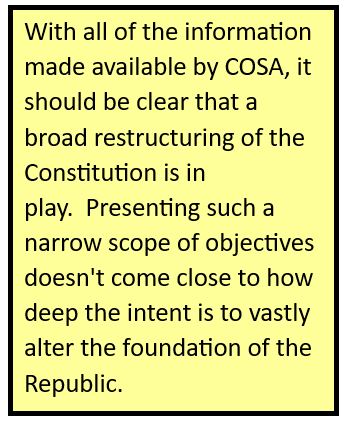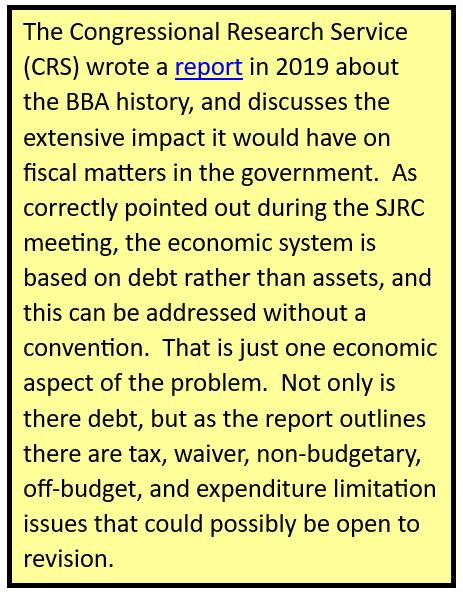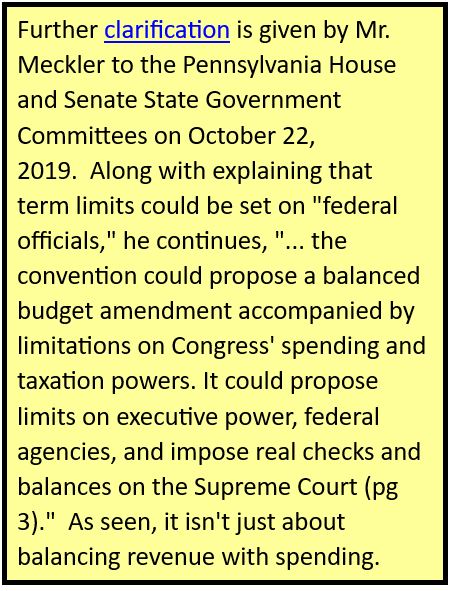
Balanced Budget & Term Limit Resolutions
By Karen Schumacher
 On March 1, 2024, the Senate Judiciary & Rules Committee (SJRC) voted to send SCR 114 and SCR 115 to the floor for a vote. SCR 114 addresses Term Limits, and SCR 115 addresses a Balanced Budget amendment (BBA). Both resolutions include the language “call a convention” or “calling of a convention of the states.” The bottom line is, many Americans do want something done to get a naughty federal government under control. To watch the meeting it can be found here under Mar. 1, 2024 1:30 P.M. Download Audio/Video.
On March 1, 2024, the Senate Judiciary & Rules Committee (SJRC) voted to send SCR 114 and SCR 115 to the floor for a vote. SCR 114 addresses Term Limits, and SCR 115 addresses a Balanced Budget amendment (BBA). Both resolutions include the language “call a convention” or “calling of a convention of the states.” The bottom line is, many Americans do want something done to get a naughty federal government under control. To watch the meeting it can be found here under Mar. 1, 2024 1:30 P.M. Download Audio/Video.
Much is written about the interpretation of Article V and the language that either Congress proposes amendments, or on the application of the legislatures of two thirds of the several states shall call a convention for proposing amendments. This document states if two-thirds of state legislatures transmit applications favoring a convention Congress must call a convention, which then decides whether to propose amendments, and if so drafts them.
 The Federalist Society discusses the differences between “plenary” and “aggregated” applications for a convention. Plenary means the application is unlimited or consideration is given for any amendments. Aggregated refers to combining applications with the same subject matter into one common language, or aggregating them together to make them consistent between states which leads to a plenary convention. As the Federalist Society explains it, “all valid applications must be aggregated with all other valid applications to yield a plenary result (pg 53).” In the case of a BBA, aggregating the numerous states resolutions for a balanced budget amendment would result in a plenary or open convention.
The Federalist Society discusses the differences between “plenary” and “aggregated” applications for a convention. Plenary means the application is unlimited or consideration is given for any amendments. Aggregated refers to combining applications with the same subject matter into one common language, or aggregating them together to make them consistent between states which leads to a plenary convention. As the Federalist Society explains it, “all valid applications must be aggregated with all other valid applications to yield a plenary result (pg 53).” In the case of a BBA, aggregating the numerous states resolutions for a balanced budget amendment would result in a plenary or open convention.
In another opinion, the Center on Budget and Policy Priorities (CBPP) reflects that “states may call on Congress to form a constitutional convention to propose amendments. Congress must act on this call if at least two-thirds of the states (34 states) make the request. The convention would then propose constitutional amendments.”
There are many other opinions and interpretations, too long to list here. But it is clear that the Convention of States Action (COSA) is calling for a plenary convention, open to many amendment possibilities and not just limited to imposing fiscal restraints, term limits, and scope and jurisdiction restraints on the federal government.
 Looking specifically at opinions on the proposed BBA, there is consistent agreement that government budgetary issues are far too complex to limit it down to just a simple “balance the budget” theme.
Looking specifically at opinions on the proposed BBA, there is consistent agreement that government budgetary issues are far too complex to limit it down to just a simple “balance the budget” theme.
SCR 115 states, “the total of all federal outlays made by the Congress for any fiscal year may not exceed the total of all estimated federal revenues for that fiscal year, together with any related and appropriate fiscal restraints.”
The Congressional Research Service (CRS) wrote a report in 2019 about the BBA history, and discusses the extensive impact it would have on fiscal matters in the government. As correctly pointed out during the SJRC meeting, the economic system is based on debt rather than assets, and this can be addressed without a convention. That is just one economic aspect of the problem. Not only is there debt, but as the report outlines there are tax, waiver, non-budgetary, off-budget, and expenditure limitation issues that could possibly be open to revision. Previous attempts to balance the federal budget also exposed fiscal programs such as Medicare, Medicaid, and Social Security as possible issues for revision. Just defining the budget as needing to be balanced does not come close to all of the economic details that would be exposed for changes during a convention with this proposed amendment.
So far, 26 states have passed resolutions specific to calling for a BBA convention. Heck, even Congress, as reviewed by the CRS report, has historically and has currently proposed legislation for a BBA. Some of the language in both Idaho resolutions came from the American Legislative Exchange Council (ALEC).
Rather than read hundreds of opinions on this subject, perhaps it would be better to determine what the Convention of States Action (COSA) has to say. Surprisingly, Mark Meckler, who leads COSA, opposes a BBA because it would “give the federal government power over the states,” whereas a convention of states could impose “fiscal restraints.” He includes “restricting taxing and spending” and forcing the government to use “generally accepted accounting principles (2:59 mark).” This appears to lead to the same end, an open door to changing many fiscal matters.
Michael Farris, JD, LLM, Co-Founder of Convention of States, states a BBA is “one that COS supports” but a “BBA alone will not cure this problem.” He goes on to cite the many fiscal and other issues that would have to be addressed in which the BBA is limited and also speaks to the aggregate issue of different state BBA resolutions. He concludes that both resolutions, calling for a convention and BBA, should proceed post haste.
Further clarification is given by Mr. Meckler to the Pennsylvania House and Senate State Government Committees on October 22, 2019. Along with explaining that term limits could be set on “federal officials,” he continues, “… the convention could propose a balanced budget amendment accompanied by limitations on Congress’ spending and taxation powers. It could propose limits on executive power, federal agencies, and impose real checks and balances on the Supreme Court (pg 3).” As seen, it isn’t just about balancing revenue with spending.
While Mr. Meckler denies “Convention of States has a board member that has proposed a new constitution” in response to criticism regarding Robert P. George, it was announced in 2014 that the COS Project formed a “Prestigious Legal Board of Reference” which included Mr. George as a board member. “The conclusions of these prestigious experts are memorialized in The Jefferson Statement.” This board crafted The Conservative Constitution. On page 11 it summarizes information related to finance, taxing, and spending. The actual Article I, Sections 9 and 10 can be found on pages 20-21 where more specific details are provided on fiscal policy and outlines how much “fiscal restraint” could, or would be applied. Given this is a COS project it might be considered as a source for consideration of possible proposed amendments that might occur during a convention, which would dramatically alter fiscal policy as various opinions have warned. Mr. George is listed as serving “as a legal advisor to the Project.” All of the proposed Articles in this Conservative Constitution dramatically reconstruct our Constitution and Bill of Rights.
Mr. George is also a member of the Council on Foreign Relations.
In the COSA plenary resolution template, it does include fiscal restraints as one of the “limited” subjects, or rather “to a small range of subjects while still allowing for multiple amendments to be proposed.”
As for SCR 114, opinions are far more varied with multiple reasons as to why term limits are a bad idea, and why it is a good idea. However, the most frightening aspect is just how far these term limits would go according to COSA. As Mr. Meckler stated, these term limits aren’t limited to just Congress, it also includes federal officials, Supreme Court justices, and federal judges. Once again, the People have failed to do their job in ousting officials who don’t adhere to the Constitution.
With all of the information made available by COSA, it should be clear that a broad restructuring of the Constitution is in play. Presenting such a narrow scope of objectives doesn’t come close to how deep the intent is to vastly alter the foundation of the Republic.
The original convention that created our Constitution emerged with delegates from each state coming together, it was initiated by them to the Continental Congress and an Act was declared for them to meet. Today, this isn’t coming from states, it is coming from a highly organized political campaign that is primarily funded by one individual. The question has to be why, what is the motivation of one person to personally fund so much activity, not only to interfere in state elections, but to also pursue avenues that would potentially cause such profound changes in the Constitution. Should it not be done as was the 1787 convention, brought forward by state leaders, whether by Governors or legislators?